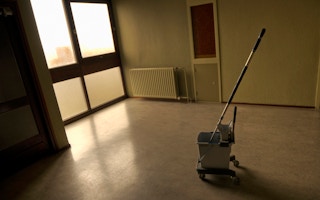Imagine a hotel where all cleaning operations are monitored and managed remotely, maintenance is predicted, uptime is optimised, and trouble-shooting solutions are just a click away.
Automation and equipment connectivity are transforming the efficiency and effectiveness of cleaning and hygiene regimes in kitchens, guest rooms, laundries and public areas. With tightening labour markets and at the same time, owners and guests each looking for more value from hotel management groups, new technologies are emerging to change the game to drive improved productivity and results.
Many governments are now engaging with business to offer incentives and support to adopt technology that empowers a leaner way of working. This article shares insight into the next epoch of cleaning and hygiene and how governments and businesses are forming alliances to support the latest in cleaning robotics, remote monitoring and cloud-based information intelligence.
The three epochs of cleaning and the Internet of Clean
The evolution of cleaning in Asia Pacific has been rapid. Let’s call the first epoch “Mops and Buckets”. Ten years ago, mops, rags and buckets, together with the strong backs of workers, cleaned most surfaces.
Then came the second epoch and we can call it “Tools and Materials”. Over time, cleaning companies used customised tools and materials that dramatically improved hygiene and cleaning levels, and to a degree, productivity. Micro-fibre replaced rags, pre-wet mops replaced buckets, and customised trollies and cleaning machines helped ease the stress on those sore backs.
“
The inclusion of robotic and internet technology within the cleaning industry will help to enhance the image of the cleaning industry…bringing about a gradual change in attracting younger and technically qualified workers into the industry, whilst making our environment greener for the future.
However, the perception of potential workers regarding cleaning is still stuck in the Mop-and-Bucket epoch. Also, the productivity and hygiene improvements rendered during the “Tools and Materials” epoch have largely been maximised.
The third and next epoch is an exciting one and we would like to call it the “Internet of Clean”. This is where the game is changing and perceptions are shifting. Cloud-based data, remote monitoring and measuring, and robotics will not only drive the next leap in productivity but will also help to forever shift the perception of cleaning from that of a Mop and Bucket to one that is knowledge-based and more desirable to potential employees.
Disruptive technologies and cleaning innovations
Like many other industries, the cleaning industry is undergoing a facelift through disruptive technologies that are driving greater automation. While this trend is reducing the amount of physical labour needed for cleaning jobs, it is at the same time enhancing the productivity and efficiency of workers in this industry.
In Singapore, the government is looking to improve standards and productivity within the cleaning sector through the implementation of a cleaning licensing regime. It emphasises the need for cleaners to hone their skills and expertise by participating in workforce skill qualification courses and learning how to operate specialised cleaning machines, such as robotic cleaning machines to improve productivity.
A productive cleaning industry that is also at the same time sustainable, makes good business sense. Smart cleaning technology across different equipment and platforms can help businesses be more sustainable and efficient by reducing water and chemical usage, strengthening chemical dosing accuracy, improving hygiene compliance and raising labour productivity and safety.
For example, the use of the right robotic cleaning machines will not only reduce water and chemistry waste, but also increase productivity through the planning of cleaning routes in advance. While a typical cleaner would be able to clean 300 square metres of floor area per hour, a robotic cleaning machine is able to clean three times the area in the same amount of time, without the need for breaks.
The robots can also be programmed to travel along the planned route, sensing and reacting to obstacles along the way. With this, cleaners can be re-deployed to perform other cleaning tasks and re-trained to perform higher skilled tasks, while the robots take over the large-scale routine cleaning tasks that typically require many hours of manual labour. Currently, Intellibots – Sealed Air’s robotic cleaning machines - are deployed at places such as Changi Airport and Marina Bay Sands in Singapore.
Robotics is just one facet of the next epoch of cleaning which will be an exciting journey ahead, as more emerging technologies define the future of cleaning.
Building a connected future with Internet of Clean (IoC)
At Sealed Air, we are defining this future through the Internet of Clean™ (IoC), which is a platform that connects machines, dispensers, sensors and other smart devices. While not all cleaning tasks can be replaced with connected solutions, technological advances can be further developed and customised to meet the needs of the cleaning industry and transform businesses from reactive to proactive and predictive. Cleaners and robots of the future will be working hand in hand to meet the ever-increasing standards of cleaning.
The Internet of Clean is Sealed Air’s vision of a future that involves workers working with smart technologies in highly connected facilities. It is already defining the future through a wave of innovations that include the Intellicare, which helps to monitor hand hygiene to prevent infection and improve working productivity; Intellidish, a cloud-based monitoring system that offers a customised and connected approach to industrial dishwashing; Intellibot floor cleaning robots; and IntelliTrail, a remote cleaning fleet management tool. Smartview is another IoC technology that has been deployed in thousands of sites in Europe, and in Asia, it is already in use by a hotel in India for real-time monitoring and reporting of cleaning tasks in their rooms.
The inclusion of robotic and internet technology within the cleaning industry will help to enhance the image of the cleaning industry, to one that is professional and productive, thereby bringing about a gradual change in attracting younger and technically qualified workers into the industry, whilst making our environment greener for the future. Indeed, it is exciting times ahead for the industry.
T. Balakrishnan is Vice President, Diversey Care Asia Pacific of Sealed Air.











